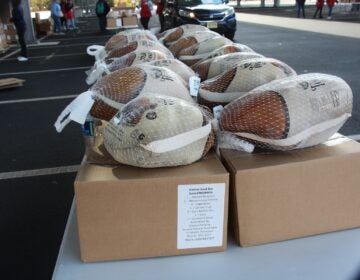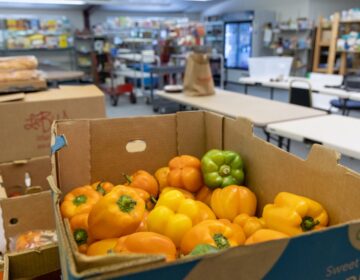Pressure on Food Banks and Pantries as Demand Surges with Rising Jobless Ranks
Food distributors hit by reduced donations, higher prices and fewer volunteers
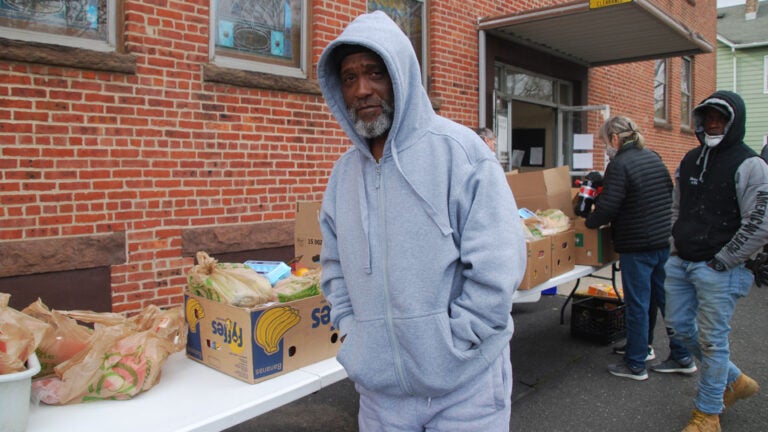
Roderick Sanders came to pick up food at a Long Branch food pantry after losing his job in a local restaurant. (Jon Hurdle/NJ Spotlight)
In the windswept parking lot of St. Luke’s United Methodist Church in Long Branch, Roderick Sanders got out of his car and walked up to a table where volunteers wearing masks against the COVID-19 pandemic were handing out boxes of food to anyone who wanted them.
Sanders lost his job preparing food and washing dishes in a nearby restaurant on March 15 when the restaurant closed in response to the pandemic, and he said he is now dependent on food handouts like the one he got from St. Luke’s food pantry on Friday.
“I wouldn’t be able to eat if it wasn’t for places like this,” said Sanders, 53, who made $12 an hour at the restaurant where he worked for 10 years.
A few minutes later, Paul Jayme arrived in a station wagon driven by his mother, and loaded in a box of food that included eggs, dried beans, canned fruit, and other essentials. Jayme said he lost his job with a heating and air conditioning company that shut down because of the pandemic last month; he has moved in with his mother because he has no income and no savings, and has been unable to find another job.
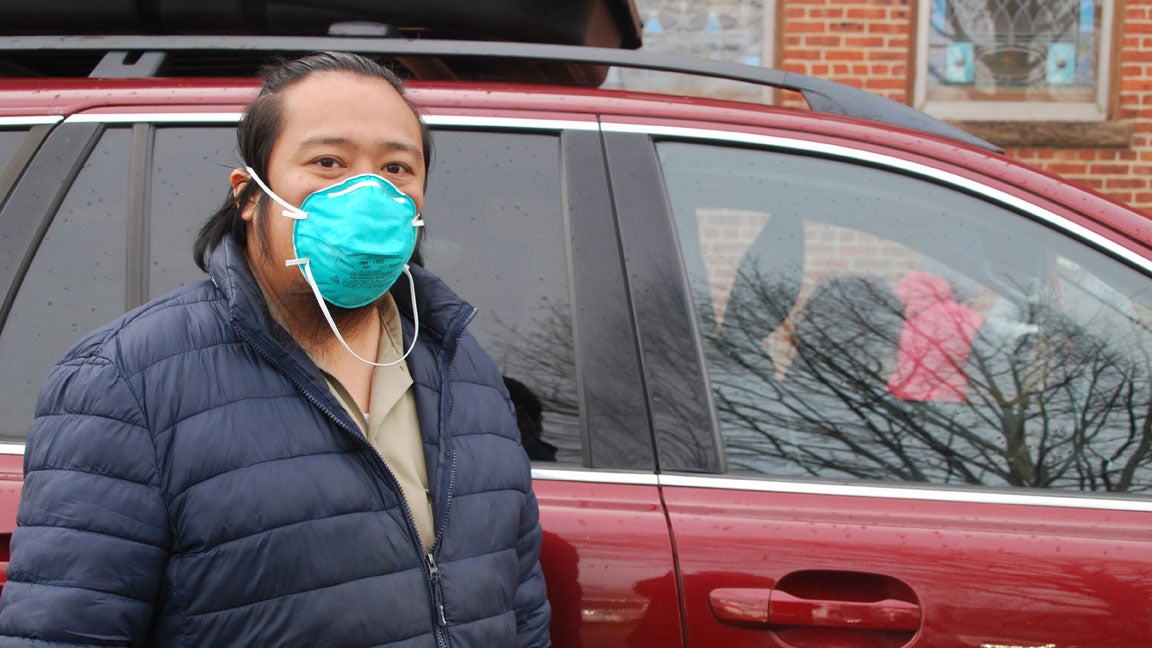
“I had to move back home because I don’t have any money,” said Jayme, 39, wearing a face mask. “There was an opening but now I can’t even go for an interview, nothing.”
An unprecedented 577,000 New Jerseyans filed new unemployment claims in the last three weeks after the state forced nonessential businesses to close in an effort to curb the spread of the coronavirus, which as of April 11 had killed 2,183 people and infected more than 58,000, according to the Department of Health. The sudden joblessness of people like Sanders and Jayme has created huge new demands for pantries like St. Luke’s and the food banks that supply them.
Serving 900,000 people
At the Community Food Bank of New Jersey, which operates in 16 counties, demand for its food has risen about 40% because of the pandemic, bringing the total number of people served to around 900,000, said its president, Carlos Rodriguez.
“It’s not hard to imagine why when you have more than 500,000 newly unemployed New Jerseyans,” Rodriguez said. Many are now dependent on food pantries and soup kitchens because they have little or no savings, as shown by a 2019 Federal Reserve survey which found 40% of Americans don’t have $400 in the bank to cover unexpected expenses.
The speed and size of the current surge in joblessness dwarfs the effects of both the Great Recession and Superstorm Sandy in 2012, Rodriguez said.
“You saw some need like this in the early days of the recession of 2008-09, and you saw some of this during Sandy but I’ve never seen anything like this,” he said. “When have you ever seen a surge of half a million unemployed people in a moment?”
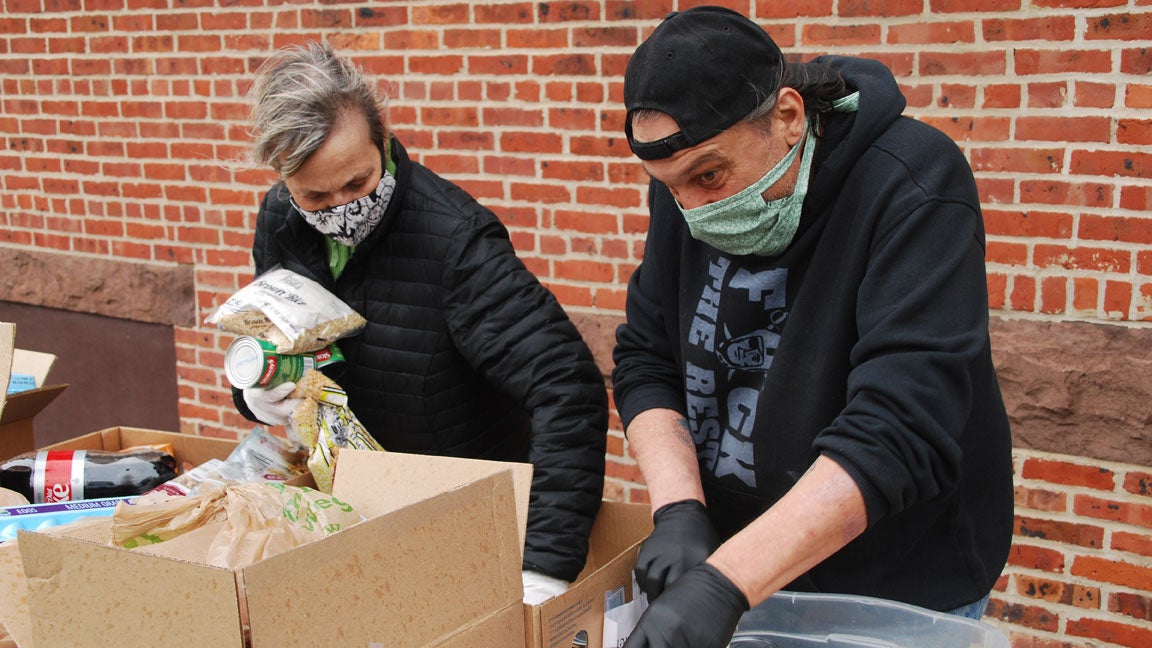
As demand surges, the Community Food Bank is also faced with fewer donations from food companies that are struggling to supply paying customers like supermarkets; higher prices for the foods they choose to buy; a diminished capacity to take volunteers because of social-distancing regulations in their warehouses, and an inability to host fundraising events that might pay for the increased expenses. Rodriguez said food donations are down about 55% since the COVID-19 crisis hit; his organization has spent about $500,000 more on food in the first month of the crisis than it normally does in that time, and the food prices have risen around 15%.
Unprecedented fundraising and logistical challenges
“If the supermarkets are having trouble stocking their shelves, you can only imagine what we’re going through,” he said. “It’s a fundraising challenge and a logistical challenge of a magnitude that we’ve never seen before.”
Rodriguez said 20%-25% of partner organizations have shut down temporarily during the pandemic, either because they have lost volunteers, or can’t operate with social distancing. As a result, his group is looking for other premises such as Boys and Girls Clubs where it can distribute food.
It is also hindered by social distancing, which sharply slows the speed with which incoming food can be received, selected and loaded. The whole process used to take 10 hours but now takes 24 hours in three eight-hour shifts, Rodriguez said.
Help for beleaguered food distributors is coming from the New Jersey Pandemic Relief Fund, a group set up by First Lady Tammy Murphy, which last week announced grants of $5,000 to $25,000 for 110 food-service organizations affiliated with the three major New Jersey food banks: the Community Food Bank, the South Jersey Food Bank, and Fulfill, formerly the Food Bank of Monmouth and Ocean Counties.
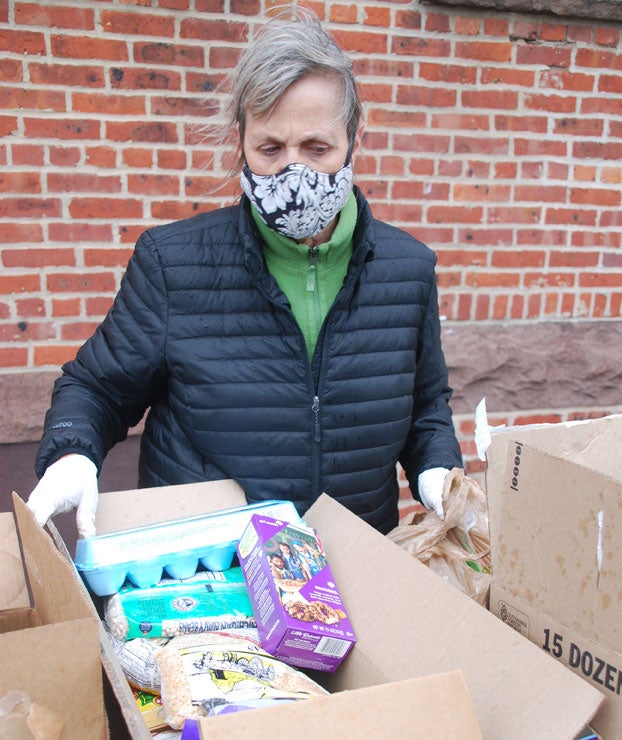
The grants can be used for food sourcing, operating expenses, increasing capacity, and helping recipients safely supply food to people who have been infected with COVID-19.
“Without this assistance, some pantries might have had to close their doors or reduce services, leaving neighbors searching for their next meal and putting additional pressure on the other local organizations,” Murphy said in a statement.
‘Crisis boxes’
At Fulfill, some 2,000 volunteers are ready to make “crisis boxes” which will feed a family of four for four days, said Kim Guadagno, president of the group, and the state’s former lieutenant governor. But the bank’s capacity to fill the boxes is severely limited by social distancing which means that only 15 people can work at one time, in two separate shifts five and a half days a week.
Fulfill tightened its social-distancing policy last week after the death on April 6 of Diana Tennant, 51, an employee for 12 years, from complications of COVID-19.
Despite the challenges of meeting increased need, Fulfill has created 7,500 crisis boxes over the past 25 days — compared with none a year ago at this time — and has made 360,000 more meals in the same period than it did a year earlier, Guadagno said.
In a bid to feed the hungry while providing some support to shuttered restaurants, Fulfill is also paying restaurants $5 for each meal that they cook for people who need them. The meals are worth a lot more than $5 but the program is designed to generate at least a little income for the restaurants, and help keep them in business, she said.
Preparing for months of hardship at the Shore
With their heavy reliance on the hospitality industry along the Shore, Monmouth and Ocean counties have been hard-hit by the pandemic and may well continue to be during the economically crucial summer season, Guadagno said.
“It has shut down and it looks like it will be shut down through the summer so we have to be prepared to go and meet the unemployed and be sure they get the food they need,” she said.
Like Rodriguez of the Community Food Bank, Guadagno predicted the current crisis will do more economic damage than either Sandy or the 2008-2009 financial crisis.
“In our estimation, it’s going to be worse than after 2008 and worse than after Sandy because after Sandy there was an end. Here, I don’t see an end,” she said. “This is not a sprint; this is definitely a marathon.”
Fulfill’s biggest needs at present are “shelf-stable” milk, as well as diapers, infant formula, baby food and cleaning products, “all things you can’t buy in the store,” she said.
At the Long Branch pantry — which is now serving more than twice as many people as it normally does — Sonia Collins came to pick up food on Friday afternoon because she said she has no income and has been unable to register for unemployment benefits.
Collins, 52, said she worked two jobs — as a driver for a behavioral health program and as a security guard at night, but now she has neither, and has no savings to fall back on. She has to feed herself and her daughter; she has paid her rent for April but doesn’t know how she will be able to pay going forward.
It might have been easier if she had been able to apply for jobless benefits, but she has been unable to reach anyone to help her do that.
“I was living payday to payday,” she said. “I can’t get any of my money, and I’m just upset and disappointed.”
WHYY is your source for fact-based, in-depth journalism and information. As a nonprofit organization, we rely on financial support from readers like you. Please give today.


![CoronavirusPandemic_1024x512[1]](https://whyy.org/wp-content/uploads/2020/03/CoronavirusPandemic_1024x5121-300x150.jpg)
